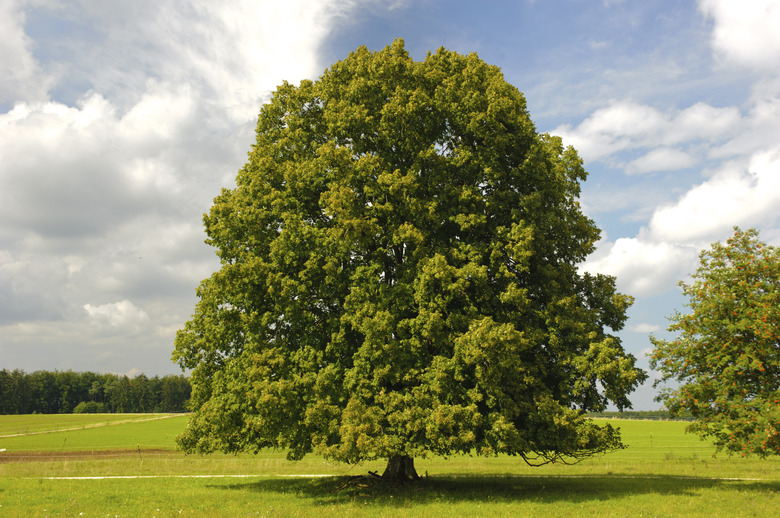Linden Tree Facts
Of the several species of linden trees grown in the United States, the American linden, or basswood (Tilia americana), is the only U.S. native. A distinctly pyramidal shape when young, a straight and sturdy trunk and glossy green leaves set it apart from other large shade trees. A slow grower,, the American linden generally reaches a maximum height of 80 feet but may exceed that measurement, depending upon soil fertility. Tolerant of a number of cultural conditions, the tree is grown as a single specimen for its shade and appearance or in a row as a windbreak. Tea can be brewed from the tree's flowers.
Physical Description
A mature American linden exhibits a more rounded and less pyramidal crown, the spread of which often equals the tree's height. The bark of a young linden is gray and relatively smooth; it becomes more deeply furrowed over time. The tree's dark-green, heart-shaped leaves are 5 to 6 inches long with toothed edges, turn yellow in fall, and are slightly hairy on a young tree. The leaves appear in late spring and are followed by clusters of fragrant, yellow flowers that attract bees. Fruit appears in late summer as pea-sized nutlets that fall from the tree by themselves or are removed by wind.
Cultural Preferences
Hardy in U.S. Department of Agriculture plant hardiness zones 3 through 6, the American linden can take a lot of harsh weather, from hard freezes in winter to drought conditions during summer and early fall as well as high winds. Although it does best in loose, rich, well-drained soil, the tree will grow in heavier clay soil, does equally well in full sun and partial shade, and tolerates a pH, or soil acidity, range of 5.5 to 7.5, which is moderately acidic to moderately alkaline.
Environmental Problems
The American linden may develop leaf scald during very hot, windy, dry weather. You can avoid damage to your linden by watering it deeply at the first sign of this condition, which appears as dry, brown edges on otherwise healthy leaves. Because the roots of most established trees grow in the top 12 to 18 inches of soil, deep watering requires moistening the soil to that depth. If you're not sure you're giving the tree enough water, then dig a small, 18-inch-deep hole under your tree, a few feet from the trunk's base, and use the amount of water that collects in the hole as a guide while you water.
Pest and Disease Concerns
Although American linden usually is not bothered by pests, a tree compromised by issues such as leaf scald may be prone to aphid infestations, which appear as curled leaves displaying clusters of small, green insects and a clear, gelatinous liquid. In order to combat aphids, spray the tree's affected leaves with a solution containing 2 tablespoons of neem oil and 1 gallon of water. Neem oil is a horticultural oil that suffocates insects. Wear a face mask, eye protection and clothing that covers your skin when handling neem oil and the neem oil-water solution. Spray the solution in early morning or late evening when no breeze is present and no rain is forecast. Cover all parts of the tree, including the bottoms of leaves, until they are wet with the solution. The solution can be applied every seven to 14 days until the aphids are gone.
An option is to buy neem oil as a premixed solution and apply it according to its package directions. Neem oil is also effective against other pests that can trouble a linden tree, including spider mites, which cause the leaves to take on a scorched appearance before falling off, and Japanese beetles, which feed voraciously on the leaves during summer.
Additional Concerns
Although leaf and seed litter from American linden does not pose a significant problem, the tree's large spreading root system can threaten nearby structures, drainage systems and other plants. Allow at least 30 feet of space between the tree and other trees as well as buildings, walkways and underground electrical wiring and pipes. The tree's roots sometimes produces sprouts that should be removed.
References
- University of Illinois Extension: American Linden, Basswood
- Fine Gardening: Control Pests and Diseases Safely with Neem
- North Dakota Tree Information Center, North Dakota Tree Handbook: American Linden or Basswood
- University of Illinois Extension: Watering Correctly Saves Time, Money and Plants
- University of Kentucky, Department of Horticulture: American Linden
- University of Florida IFAS Extension: Tilia Americana, American Linden
